
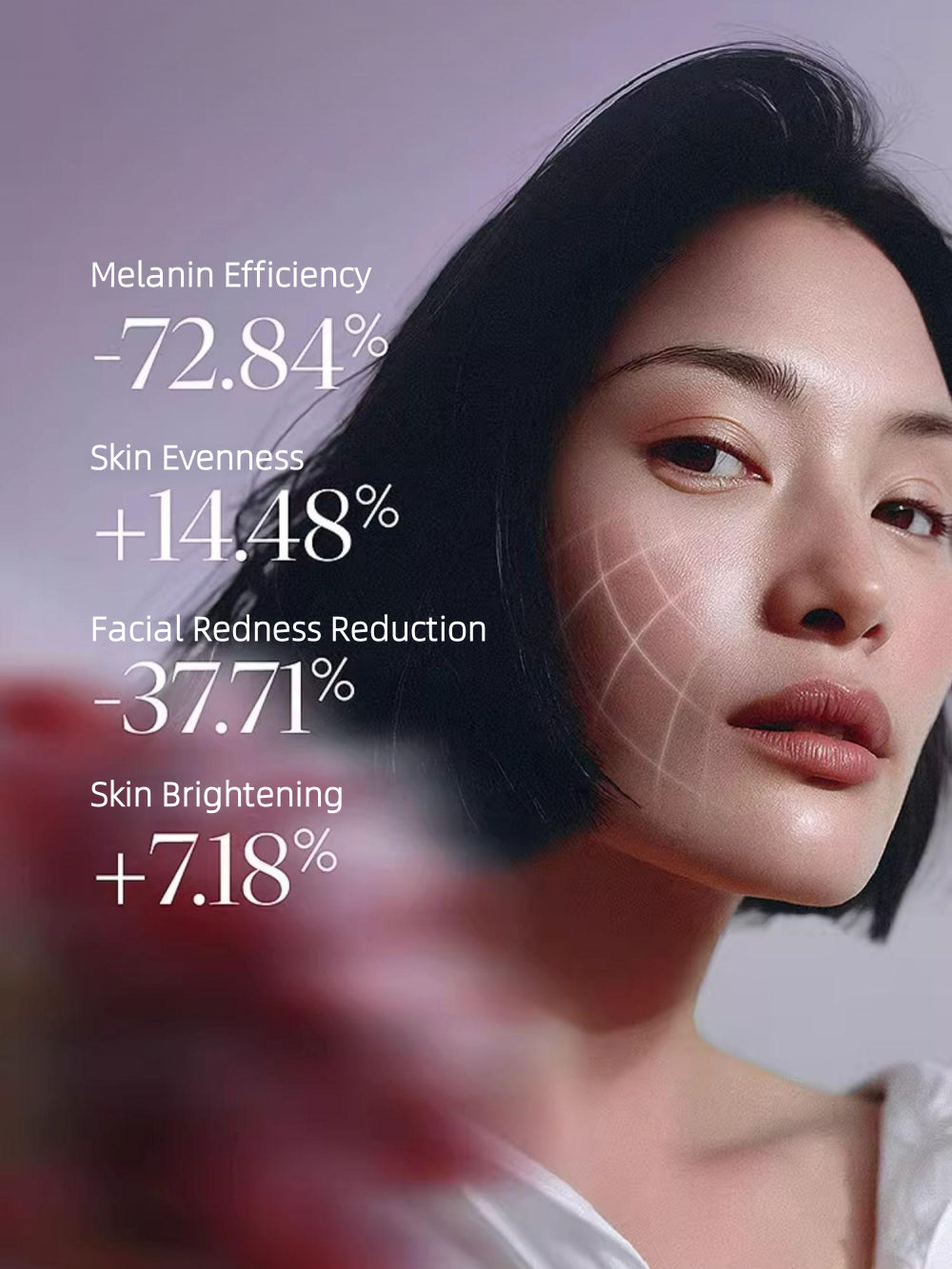
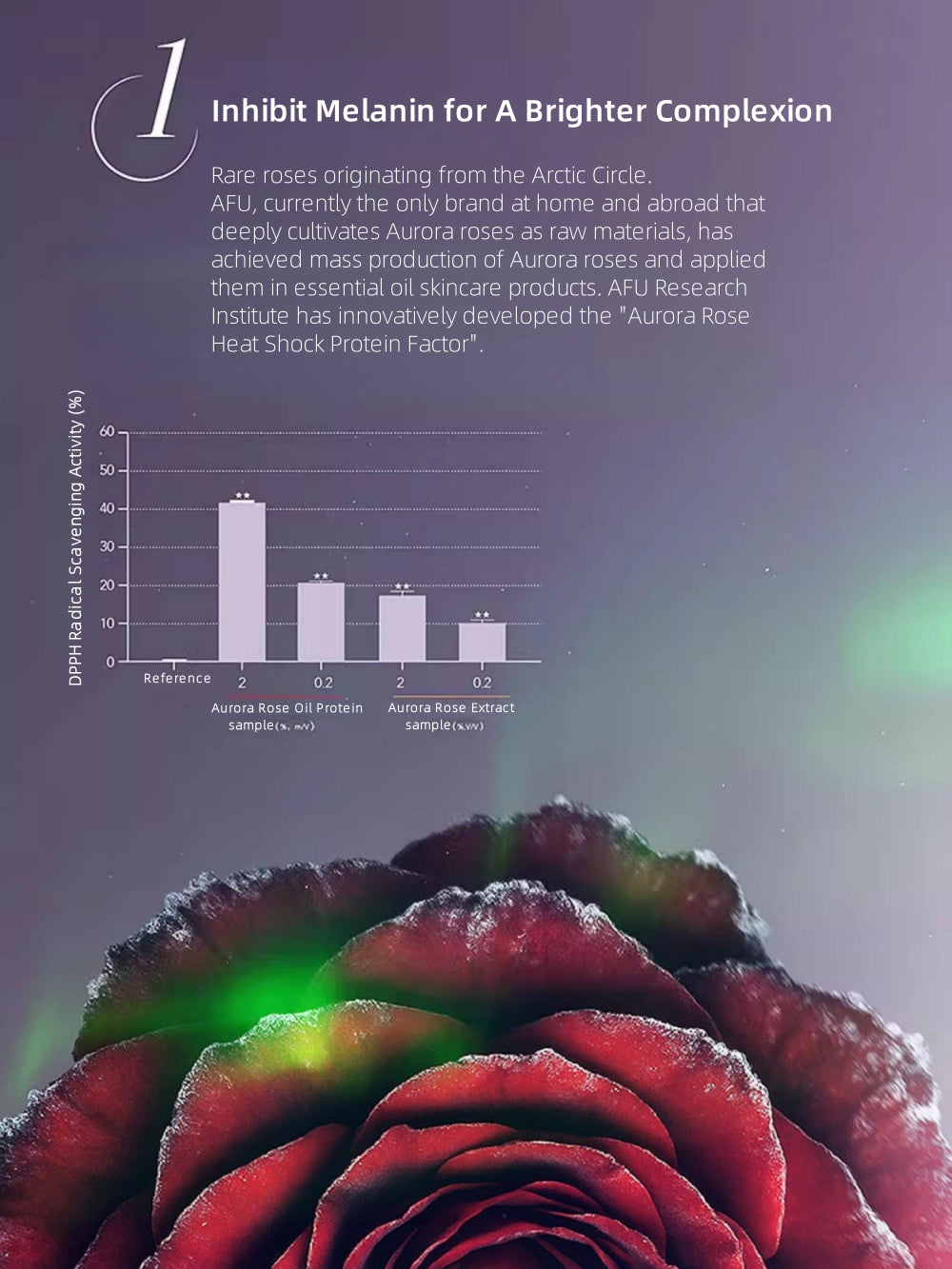
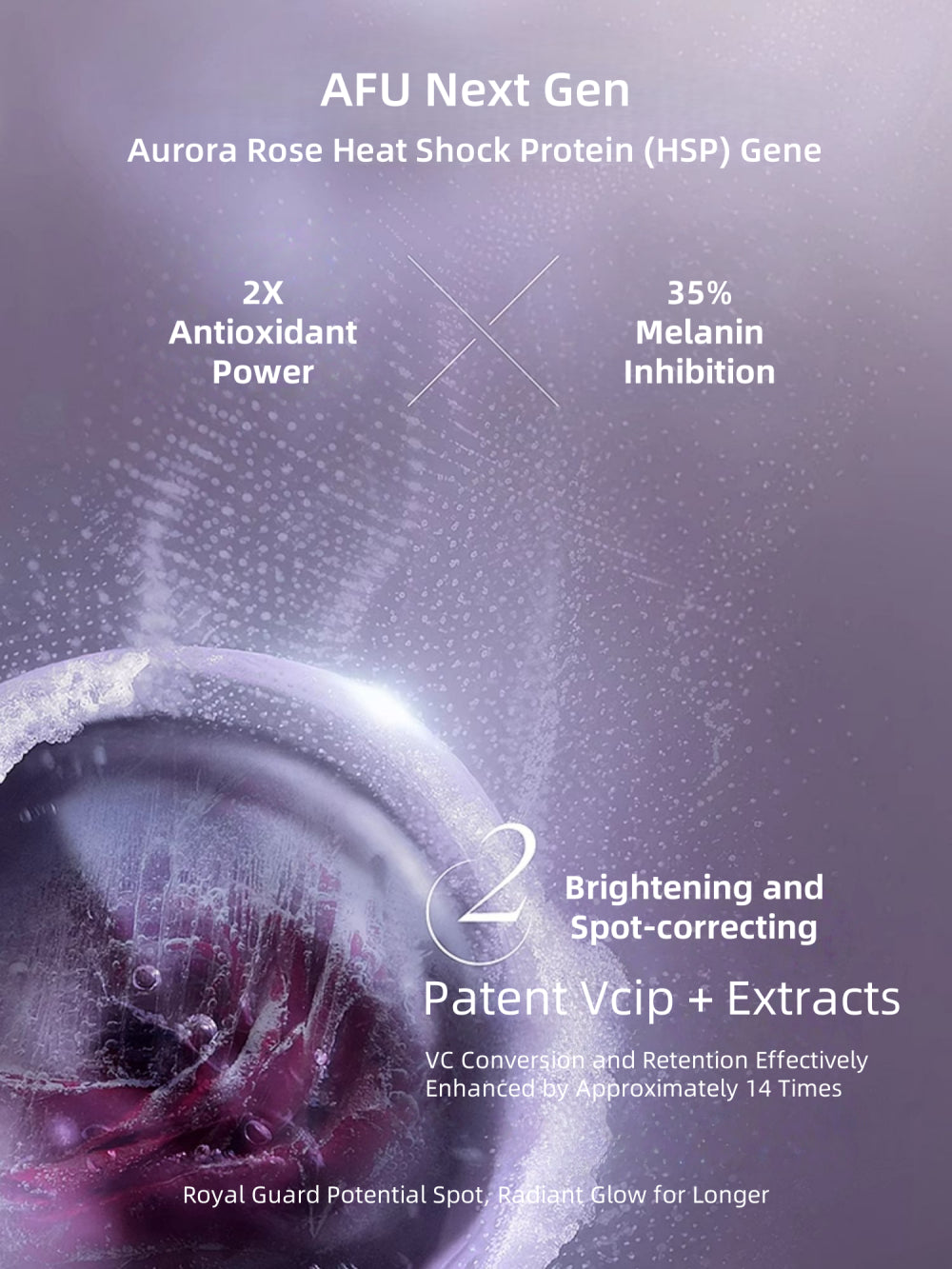
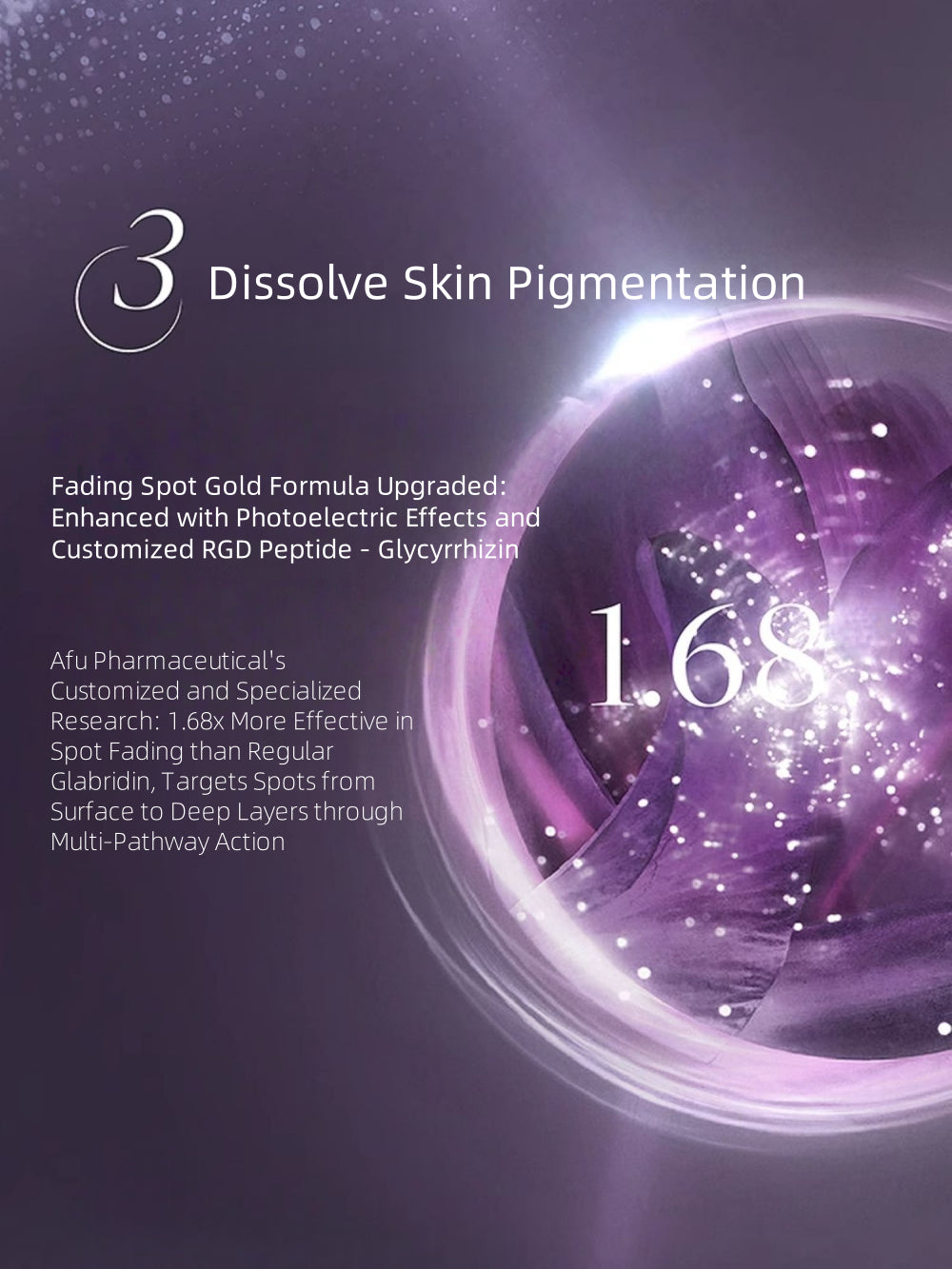


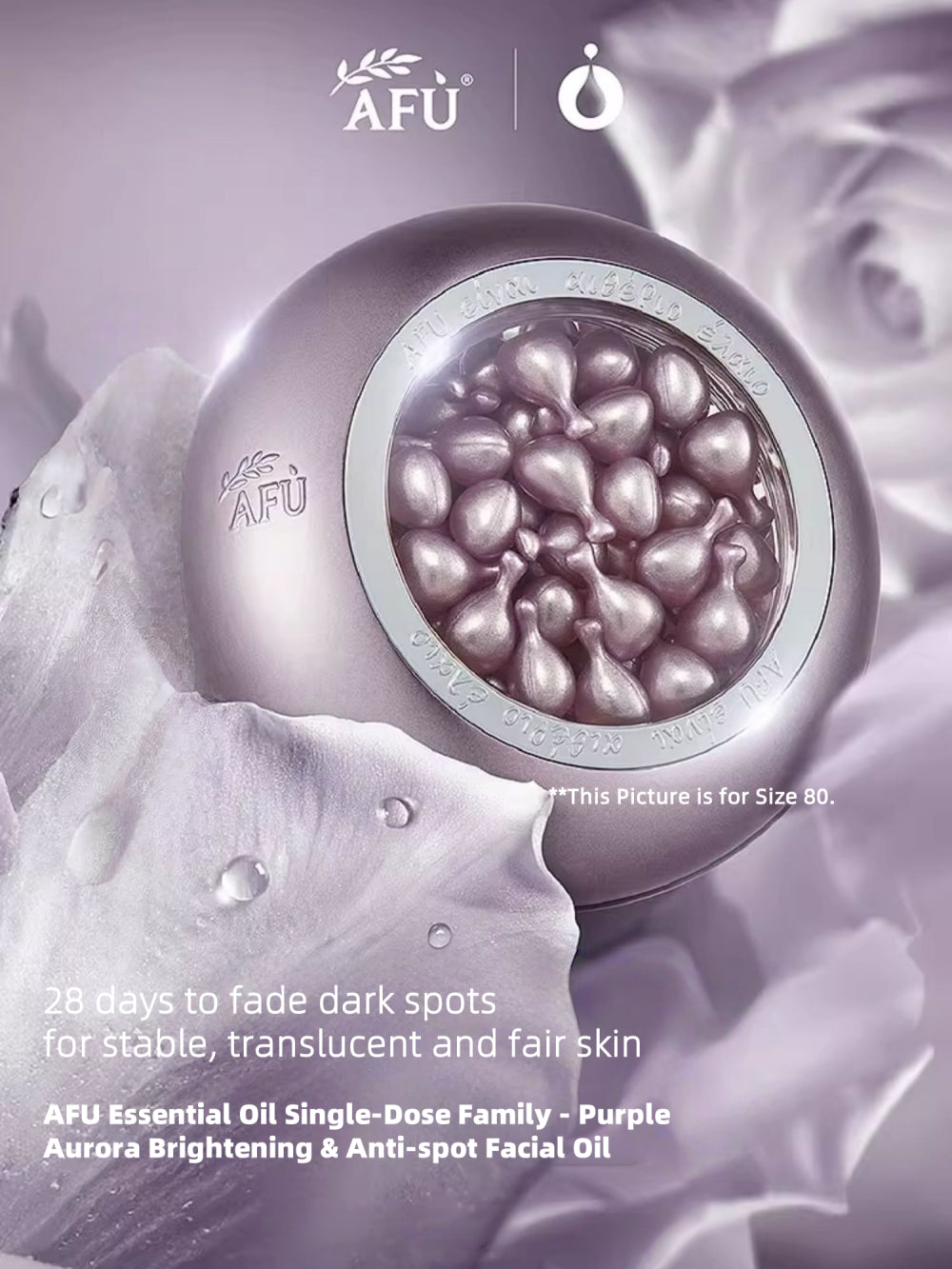
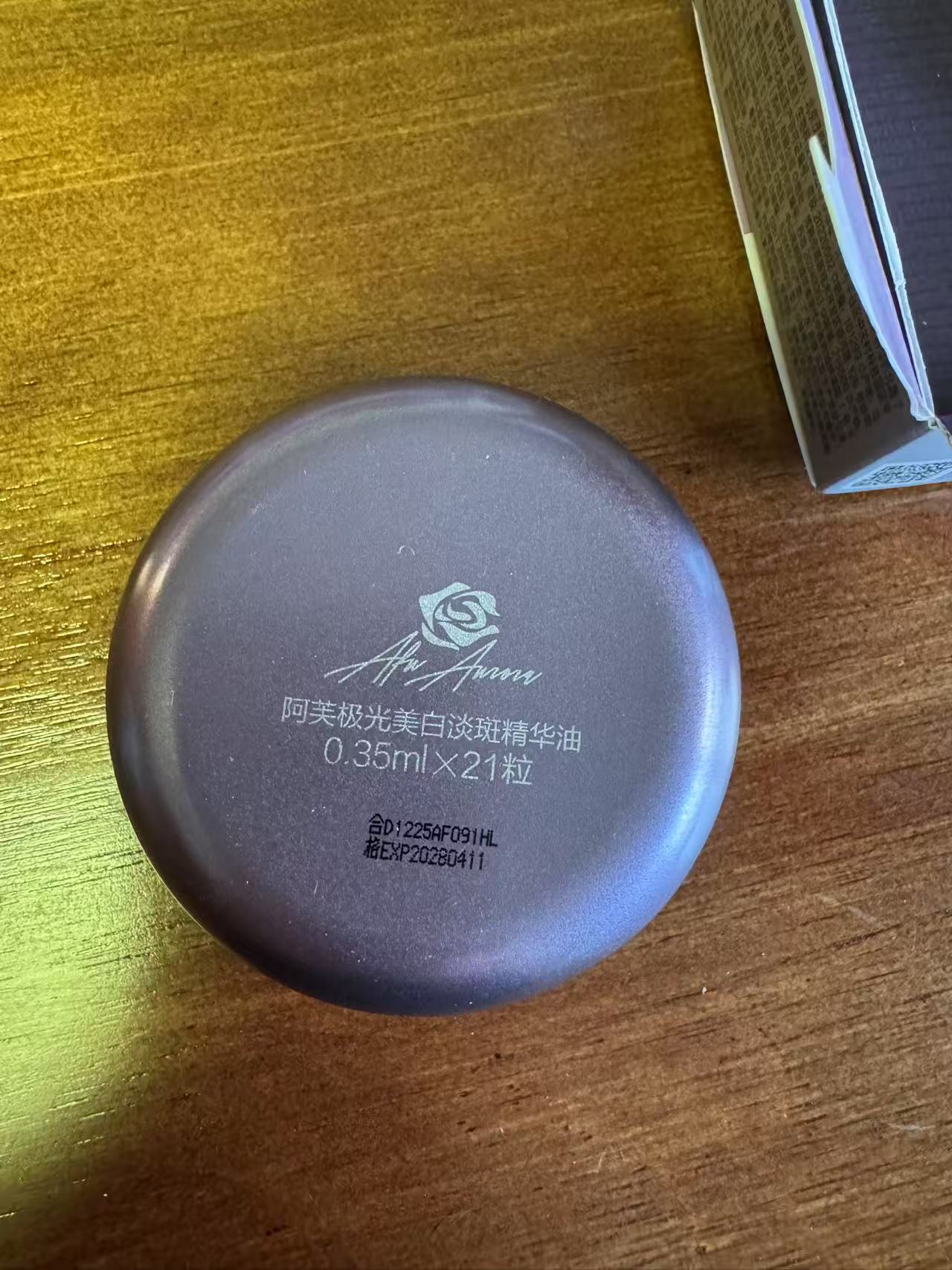
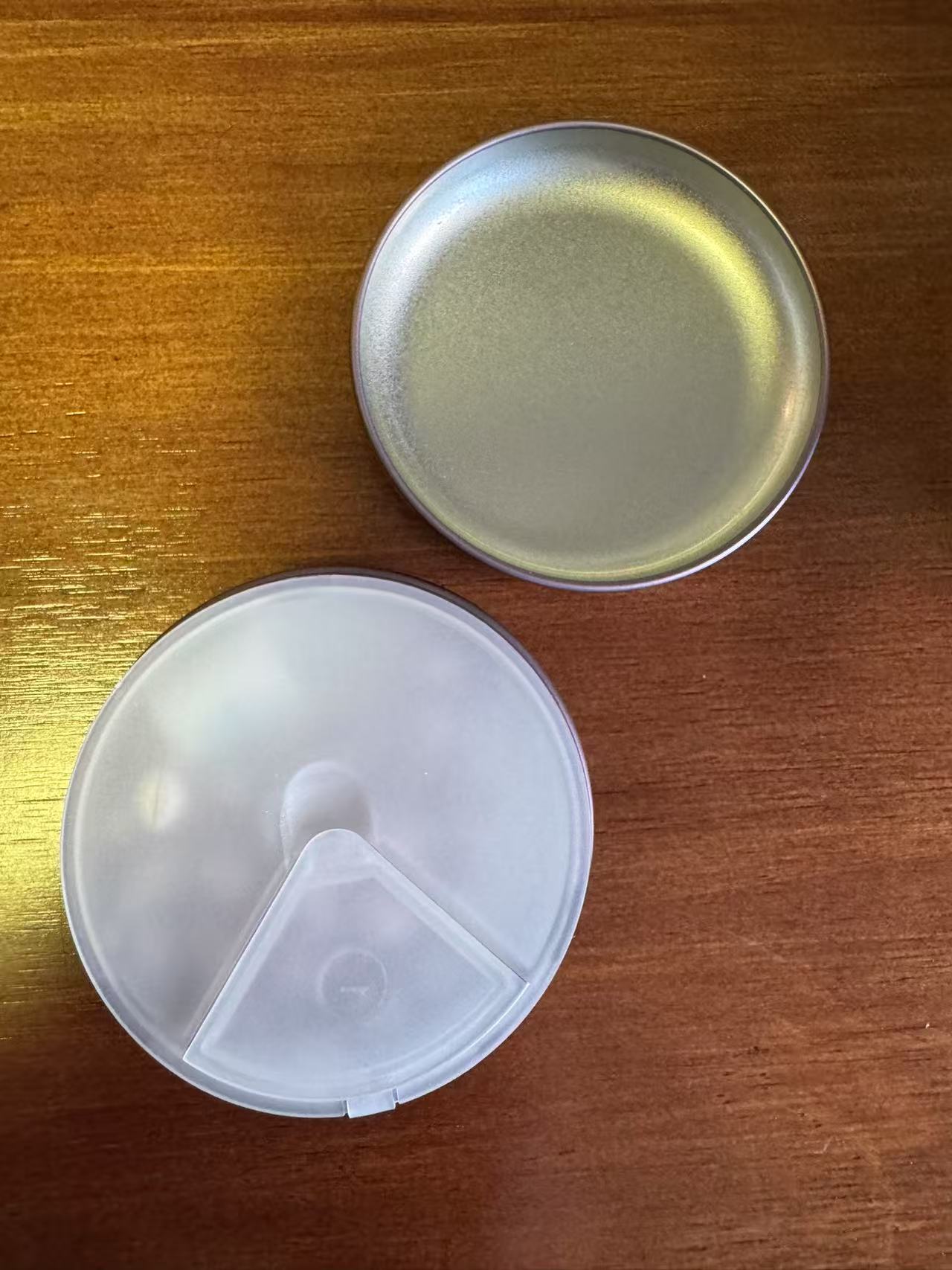
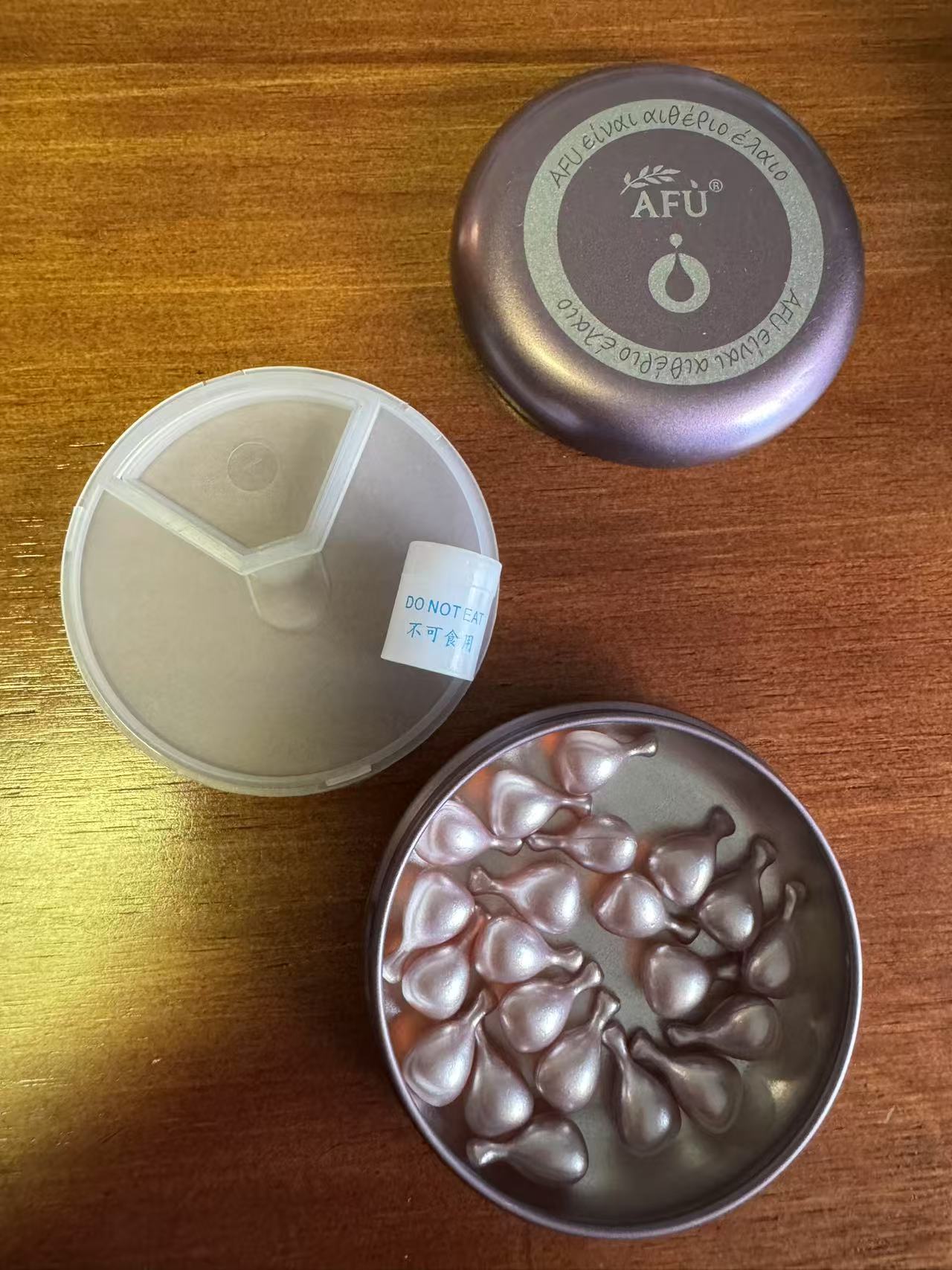
AFU Aurora Brightening & Anti-spot Facial Oil 0.35ml*21
Why Choose It?
Potent Brightening & Hyperpigmentation Targeting:
- Ascorbyl Tetraisopalmitate (Vitamin C Derivative): This is the star brightening agent. It's a highly stable, oil-soluble form of Vitamin C known for:
- Inhibiting Tyrosinase: Directly interferes with the enzyme crucial for melanin (pigment) production.
- Antioxidant Power: Neutralizes free radicals (like UV-induced ones) that trigger melanin production and cause dullness.
- Collagen Synthesis: Supports collagen production, improving skin radiance and texture over time.
- Penetration: Its oil-soluble nature allows for better penetration into the skin compared to pure L-ascorbic acid, especially in an oil base.
- Pterocarpus Marsupium Bark Extract (Indian Kino/Malabar Kino): This is a key anti-spot ingredient. Research suggests it has significant tyrosinase inhibitory activity, comparable to or even stronger than some well-known brighteners like kojic acid or arbutin. It specifically targets the overproduction of melanin causing dark spots.
- Glycyrrhizin (Licorice Root Extract): A well-respected brightening ingredient. It inhibits tyrosinase, has anti-inflammatory properties (reducing redness often associated with PIH - Post-Inflammatory Hyperpigmentation), and soothes the skin.
- Citrus Oils (Leaf, Peel, Flower - Use with caution): Citrus oils (like Citrus aurantium amara leaf, C. aurantium dulcis peel, C. limon peel) contain compounds (limonene) that can offer some brightening effects and antioxidant benefits. Crucially Important: These are phototoxic and can increase sun sensitivity. Strict daily sunscreen use is NON-NEGOTIABLE with this product.
Strong Antioxidant & Anti-Aging Shield:
- Vitamin C Derivative (Ascorbyl Tetraisopalmitate): As above, a powerful antioxidant.
- Tocopheryl Acetate (Vitamin E Derivative): Another major antioxidant that protects cell membranes from free radical damage. Works synergistically with Vitamin C to enhance its stability and effectiveness. Also supports skin barrier health.
- Plant Oils (Rosa Rubiginosa/Rosehip, Simmondsia Chinensis/Jojoba, Squalane, Olive, Limnanthes Alba/Meadowfoam): These oils are naturally rich in antioxidants (like tocopherols, carotenoids) that combat environmental stressors (pollution, UV).
- Pterocarpus Marsupium & Glycyrrhizin: Also contribute antioxidant activity.
- Citrus & Floral Oils: Provide antioxidant compounds, though their primary benefit here is likely fragrance.
- Intensive Nourishment, Barrier Repair & Moisture Lock:
- Base Oils Blend (Rosehip, Jojoba, Squalane, Phytosteryl Oleate, Olive, Meadowfoam): This combination offers a spectrum of fatty acids, sterols, and emollients:
- Mimics Skin Lipids: Squalane and Phytosteryl Oleate (a phytosterol ester) are particularly good at reinforcing the skin's natural barrier.
- High Linoleic Acid (Rosehip): Beneficial for acne-prone skin and barrier repair.
- Non-Comedogenic: Jojoba, Squalane, and Meadowfoam are lightweight and unlikely to clog pores.
- Occlusion: Creates a protective layer to prevent Transepidermal Water Loss (TEWL), keeping skin hydrated and plump.
- Nourishment: Delivers essential fatty acids and nutrients directly to the skin.
Anti-Inflammatory & Soothing Support:
- Glycyrrhizin (Licorice): A potent anti-inflammatory, calming redness and irritation, crucial for treating PIH.
- Rosehip Oil: Contains compounds like tretinoin-precursors (very mild) and has known anti-inflammatory properties.
- Lavender Oil: Traditionally used for its calming and soothing properties (Lavandula angustifolia).
- Jojoba Oil: Naturally soothing and anti-inflammatory.
- Pterocarpus Marsupium: May also offer some anti-inflammatory benefits.
Enhanced Skin Texture & Tone:
- Vitamin C Derivative: Promotes collagen synthesis, improving skin firmness and smoothness over time, contributing to a more even texture.
- Exfoliation (Mild): Rosehip oil contains natural retinoids that can promote gentle cell turnover. Vitamin C also aids in this process.
- Deep Hydration & Plumping: The rich oil blend significantly hydrates and plumps the skin, making fine lines appear less noticeable and skin look smoother and more radiant.
- Glycoprotein & Polyamino Acid Polysaccharide Condensate: These are film-forming humectants or conditioning agents. They help retain moisture, improve skin feel (silkiness, smoothness), and may provide a subtle plumping effect.
Key Considerations & Potential Drawbacks:
- Essential Oils & Sensitivity: The significant number of essential oils (Citrus Leaf/Peel/Flower, Rose Flower, Lavender, Jasmine) is a major consideration. While they contribute fragrance and some benefits, they are common irritants and allergens. Patch testing is highly recommended, especially for sensitive, reactive, or acne-prone skin.
- Phototoxicity: The Citrus oils (especially the peel oils: C. aurantium dulcis, C. limon) are phototoxic. Daily broad-spectrum SPF 30+ is absolutely essential when using this product, even on cloudy days. Failure to do so can increase the risk of pigmentation and sun damage.
- Concentration Unknowns: While ingredients above 0.1% are listed, the exact concentrations of key actives (like Ascorbyl Tetraisopalmitate, Pterocarpus extract, Glycyrrhizin) are unknown. Efficacy depends heavily on sufficient concentration.
- "Anti-Spot" Timeline: Treating hyperpigmentation requires consistency and patience. Significant results typically take 8-12 weeks of consistent use.
- Oil Texture: While the blend includes lighter oils, it's still an oil product. It might feel too heavy for very oily skin types, especially in humid climates. It's likely best suited for dry, combination, or normal skin, or used sparingly by oilier types.
In Summary:
- The AFU Aurora Brightening & Anti-Spot Facial Oil presents a well-designed, multi-targeted approach to its claims:
- It leverages potent, stabilized Vitamin C (Ascorbyl Tetraisopalmitate) and a clinically relevant tyrosinase inhibitor (Pterocarpus Marsupium) as its core brightening/anti-spot actives.
- It's bolstered by supportive brighteners (Glycyrrhizin) and a rich blend of nourishing, barrier-supportive oils.
- It offers strong antioxidant protection and soothing properties.
- It aims to improve overall skin texture, hydration, and radiance.
Crucial Caveats: The high essential oil content necessitates patch testing and makes it potentially unsuitable for sensitive skin. The phototoxic citrus oils demand strict daily sunscreen use. Efficacy for significant spot reduction depends on undisclosed concentrations and requires patience and consistency.
This oil is best for individuals with dry to normal/combination skin seeking targeted brightening and anti-aging benefits, who are not sensitive to essential oils and are meticulously committed to daily sun protection.
Ingredients
Ingredients above 0.1% (w/w):
- Rosa RUBIGINOSA seed oil, simmondsia chinensis seed oil, squalane, phytosteryl oleate, ascorbyl tetraisopalmitate, Pterocarpus marsupium bark extract, Citrus aurantium amara leaf oil, Citrus aurantium dulcis peel oil, rosa rugosa flower oil, glycoprotein, olive oil, limanthus alba seed oil
Other trace ingredients:
- Glycyrrhizin, Citrus aurantium amara flower oil, Jasmine sambac flower oil, Citrus limon peel oil, Lavandula angustifolia flower oil ANGUSTIFOLIA) oil, tocopheryl acetate, water, phenoxyethanol, polyamino acid polysaccharide condensate, ethylhexylglycerin
How to Apply
IMPORTANT PRECAUTIONS
STRICT SUN PROTECTION IS MANDATORY:
- Contains phototoxic citrus oils (Citrus aurantium dulcis peel oil, Citrus limon peel oil).
- Apply broad-spectrum SPF 30+ every morning, even indoors/on cloudy days.
- Reapply sunscreen every 2 hours if outdoors.
- Failure increases risk of sunburn, pigmentation, and counteracts brightening effects.
PATCH TEST BEFORE USE:
- High concentration of essential oils (citrus, rose, lavender, jasmine) poses high allergy/irritation risk.
- Test on a small area (e.g., behind ear/jawline) for 2-3 nights. Watch for redness, itching, or breakouts.
AVOID IF YOU HAVE:
- Sensitive/reactive skin (essential oils are common irritants).
- Rosacea/eczema (citrus oils may trigger flares).
- Very acne-prone skin (some oils may clog pores despite being "non-comedogenic" on paper).
- Citrus oil allergy (check ingredient list carefully).
DO NOT USE WITH:
- Other potent actives like retinoids (retinol, tretinoin), AHAs/BHAs (glycolic/lactic/salicylic acid), or physical scrubs in the same routine.
- Alternate nights or use on "recovery" nights to avoid barrier damage.
- Avoid direct sun exposure after application (use only at night).
DISCONTINUE IF:
- Stinging, redness, peeling, or new breakouts occur.
- Signs of photosensitivity appear (unusual sunburn).
HOW TO APPLY (Nighttime Use Only)
When to Apply:
- Use ONLY at night. Never in the morning due to phototoxic citrus oils.
- Ideal for dry, combination, or normal skin. Oily skin: use sparingly (2-3 drops max).
Preparation:
- Cleanse and tone skin as usual.
- Apply on damp skin or after a hydrating serum to boost absorption.
Application Steps:
- Dispense: Twist open 1 (0.35ml).
- Warm: Rub oil between fingertips.
- Press & Pat: Gently press onto face and neck. Avoid rubbing.
- Massage (Optional): Use upward strokes if desired for 30 seconds.
- Follow Up: Wait 1-2 minutes, then apply moisturizer if needed (often unnecessary due to oil's richness).
Frequency:
- Start with 2-3 nights/week, gradually increasing to nightly if tolerated.
- Reduce frequency if irritation occurs.
Layering Tips:
- Before: Water-based serums (e.g., hyaluronic acid).
- After: Only a light moisturizer if skin feels tight. Avoid heavy creams.
- Avoid Mixing: Do not combine with vitamin C serums, exfoliants, or retinoids.
Pro Tips
- Storage: Keep it in a cool, dark place (light degrades vitamin C).
- Results Timeline: Expect visible brightening/spot reduction after 8-12 weeks of consistent use.
- Less is More: 1 covers face + neck. Over-application increases irritation risk.
- AM Routine: Focus on hydration + sunscreen. Avoid actives that increase sun sensitivity.
Best For: Non-sensitive skin types committed to rigorous sun protection. Not recommended for sensitive, rosacea-prone, or highly acne-prone skin without dermatologist approval. Always prioritize barrier health!
SHIPPING
- Order processed and shipped out in 1-3 Business Days;
- Express by DHL Generally in 2-7 Days;
- Standard Delivery in 4-15 Business Days.
- Quick solution with returns and refunds.
- More details in Shipping Policy.
Choose options











Share An Inspiration
let this little thing illustrate.
